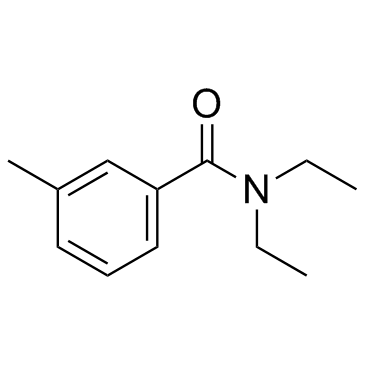N,N-Diethyl-3-methylbenzamide

N,N-Diethyl-3-methylbenzamide structure
|
Common Name | N,N-Diethyl-3-methylbenzamide | ||
|---|---|---|---|---|
| CAS Number | 134-62-3 | Molecular Weight | 191.270 | |
| Density | 1.0±0.1 g/cm3 | Boiling Point | 297.5±0.0 °C at 760 mmHg | |
| Molecular Formula | C12H17NO | Melting Point | -45ºC | |
| MSDS | Chinese USA | Flash Point | 141.7±13.3 °C | |
| Symbol |

GHS07 |
Signal Word | Warning | |
|
Degradation of N,N-diethyl-m-toluamid (DEET) on lead dioxide electrodes in different environmental aqueous matrixes.
J. Environ. Sci. Health. A. Tox. Hazard. Subst. Environ. Eng. 50 , 931-40, (2015) This study investigates the electrochemical degradation of N,N-diethyl-m-toluamide (DEET) on PbO2 and Bi-PbO2 anodes. The difference in electrode crystalline structure was responsible for the better DEET degradation and TOC removal on PbO2 than on Bi-PbO2. In... |
|
|
Cheminformatics analysis of assertions mined from literature that describe drug-induced liver injury in different species.
Chem. Res. Toxicol. 23 , 171-83, (2010) Drug-induced liver injury is one of the main causes of drug attrition. The ability to predict the liver effects of drug candidates from their chemical structures is critical to help guide experimental drug discovery projects toward safer medicines. In this st... |
|
|
Potential analytical interferences and seasonal variability in diethyltoluamide environmental monitoring programs.
Chemosphere 127 , 238-45, (2015) N,N-diethyl-m-toluamide (DEET), the active component of many insect repellents, is among the most frequently detected compounds in aqueous environments with concentrations reported in the ng L(-1) to μg L(-1) range. However, DEET is often detected in blanks a... |
|
|
Repellency of selected chemicals against the bed bug (Hemiptera: Cimicidae).
J. Econ. Entomol. 106(6) , 2522-9, (2013) In recent years, the common bed bug, Cimex lectularius L. (Hemiptera: Cimicidae), became a major public health concern in urban communities. Bed bugs are notoriously difficult to control, and their bites are not tolerated by most people. The public has an urg... |
|
|
Neurological deficits induced by malathion, DEET, and permethrin, alone or in combination in adult rats.
J. Toxicol. Environ. Health A 67(4) , 331-56, (2004) Malathion (O,O-dimethyl-S-[1,2-carbethoxyethyl]phosphorodithionate), DEET (N,N-diethyl-m-toluamide), and permethrin [(+/-)-cis/trans-3-(2,2-dichloroethenyl)-2,2-dimethylcyclopropane carboxylic acid (3-phenoxyphenyl) methyl ester] are commonly used pesticides.... |
|
|
Combined exposure to DEET (N,N-diethyl-m-toluamide) and permethrin: pharmacokinetics and toxicological effects.
J. Toxicol. Environ. Health. B. Crit. Rev. 6(1) , 41-53, (2003) Permethrin and DEET are concurrently used for pests control inside homes, in public places, and in military shelters. Combined exposure to these compounds produced greater biochemical, behavioral, and metabolic alterations in animals compared to each individu... |
|
|
Safety and efficacy of DEET and permethrin in the prevention of arthropod attack.
Mil. Med. 163(5) , 324-30, (1998) Many preventable diseases affecting troop strength are directly attributed to disease-carrying insects. The first line of defense against arthropod vectors is the use of personal protective measures. The concurrent application of DEET (N,N-diethyl-m-toluamide... |
|
|
Solvent, drying time, and substrate affect the responses of lone star ticks (Acari: Ixodidae) to the repellents deet and picaridin.
J. Med. Entomol. 51(3) , 629-37, (2014) Behavioral bioassays remain a standard tool in the discovery, development, and registration of arthropod repellents. Tick repellent bioassays are generally uncomplicated, but their results can be affected by basic variables (e.g., dimensions of testing materi... |
|
|
Ultra-preconcentration and determination of selected pharmaceutical and personal care products in different water matrices by solid-phase extraction combined with dispersive liquid-liquid microextraction prior to ultra high pressure liquid chromatography tandem mass spectrometry analysis.
J. Chromatogr. A. 1355 , 26-35, (2014) Pharmaceutical and personal care products (PPCPs) are one of the most important classes of emerging contaminants. The potential of ecological and environmental impacts associated with PPCPs are of particular concern because they continually penetrate the aqua... |
|
|
Mosquitoes smell and avoid the insect repellent DEET.
Proc. Natl. Acad. Sci. U. S. A. 105(36) , 13598-603, (2008) The insect repellent DEET is effective against a variety of medically important pests, but its mode of action still draws considerable debate. The widely accepted hypothesis that DEET interferes with the detection of lactic acid has been challenged by demonst... |